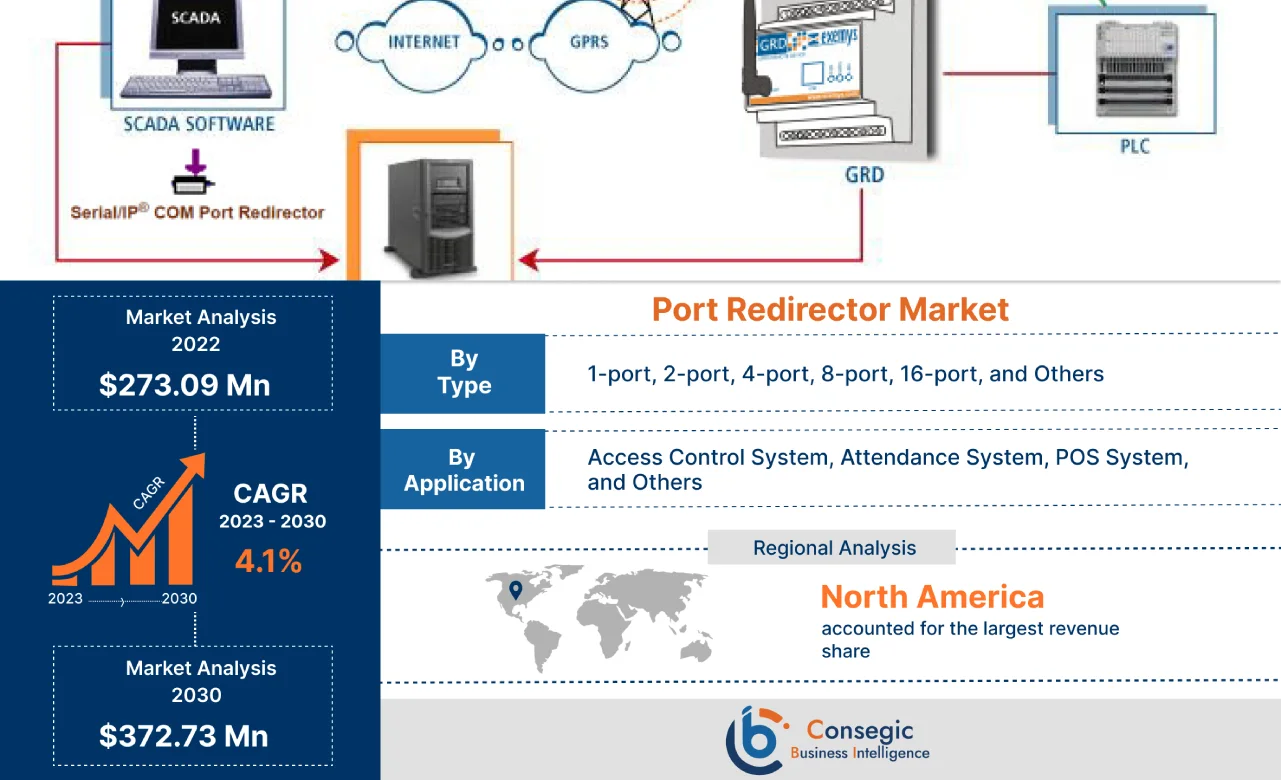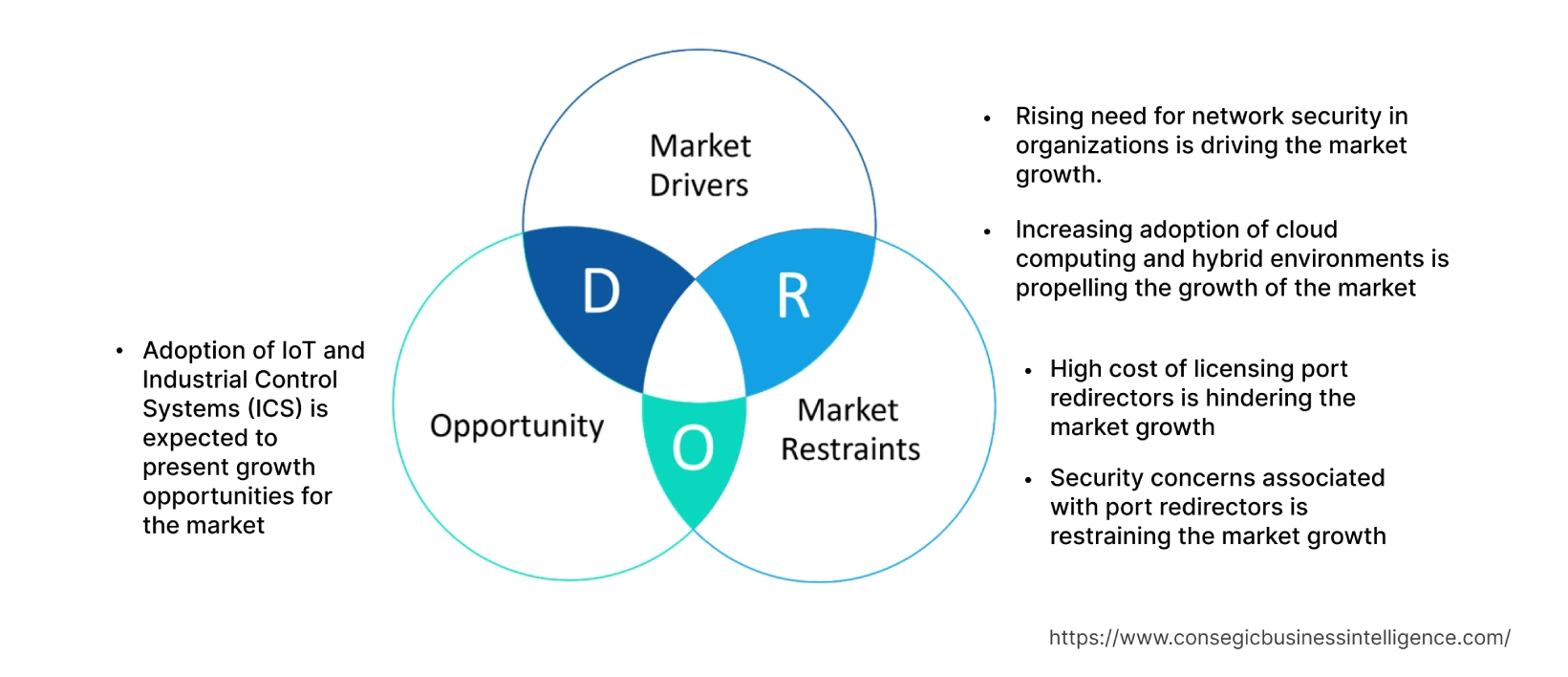- Summary
- Table Of Content
- Methodology
Port Redirector Market Introduction :
Port Redirector Market is estimated to reach over USD 372.73 Million by 2030 from a value of USD 273.09 Million in 2022, growing at a CAGR of 4.1% from 2023 to 2030.
Port Redirector Market Definition & Overview:
Port redirector is a component of networking that facilitates the redirection of incoming network traffic from one port to another. Port redirectors play a crucial role in rerouting incoming connections or data packets from a specific source port to a different destination port. Consequently, port redirectors are used for a wide range of services on devices including web servers, FTP servers, or remote desktop applications.
Port Redirector Market Insights :
Key Drivers :
Rising need for network security in organizations is driving the market growth
The rising number of cyber threats and security breaches in organizations is driving the growth of port redirector market. Organizations are focused on implementing robust security measures in order to protect critical IT infrastructure of the organization. Port redirectors play a vital role in network security by providing protection and control over network traffic. Port redirectors are utilized to divert network traffic to a different network segment or VLANs (Virtual Local Area Networks) to protect sensitive data or resources from less-trusted parts of the network. For instance, in June 2020, Hetzner Online GmbH expanded the product set of its Cloud platform by integrating load balancers to distribute incoming traffic to background IT infrastructure. Thus, the ability of port redirectors to identify potential threats in network servers is propelling the growth of the market.
Increasing adoption of cloud computing and hybrid environments is propelling the growth of the market
The rising adoption of cloud computing and hybrid IT environments has increased the complexity of network infrastructures. Cloud computing has facilitated the deployment of port redirectors in order to access the organizations' data effectively. Moreover, port redirectors play a crucial role in establishing seamless communication and connectivity between on-premise systems and cloud-based services. Consequently, the ability of port redirectors to support hybrid IT environments is propelling the growth of the market. For instance, in May 2022, Microsoft launched port tunneling (forwarding) feature to ASP.NET Core web projects for testing and developing a web app from an external device.
Key Restraints :
High cost of licensing port redirectors is hindering the market growth
Port redirector vendors charge licensing fees based on the number of users, devices, or ports being redirected. Moreover, port redirectors require dedicated hardware and software installations, thereby adding to the initial cost of purchasing port redirectors. Furthermore, high maintenance costs, including software upgrades, is further contributing to the high cost of port redirectors, thereby restraining the growth of the market.
Security concerns associated with port redirectors is restraining the market growth
The redirection of incoming network traffic by opening up different ports of the router raises security concerns, thereby hindering the growth of the market. Port forwarding creates holes in the NAT firewall that allows intruders to connect to the ports and gain unauthorized access to the organization's network. Thus, the rising concerns due to port redirection is restraining the growth of port redirector market.
Future Opportunities :
Adoption of IoT and Industrial Control Systems (ICS) is expected to present growth opportunities for the market
The adoption of port redirectors in IoT-enabled devices and industrial control systems (ICS) to facilitate communication between multiple devices is expected to present growth opportunities for the market during the forecast period. Port redirectors allow authorized devices or applications to communicate with IoT devices and ICS systems. Consequently, the ability of port redirectors to ensure authorized and reliable connections between devices is expected to drive the market growth during the forecast period.
Port Redirector Market Report Insights :
| Report Attributes | Report Details |
| Study Timeline | 2017-2030 |
| Market Size in 2030 | USD 372.73 Million |
| CAGR (2023-2030) | 4.1% |
| By Type | 1-port, 2-port, 4-port, 8-port, 16-port, and Others |
| By Application | Access Control System, Attendance System, POS System, and Others |
| By Region | North America, Europe, Asia-Pacific, Latin America, and Middle East & Africa |
| Key Players | Moxa Inc., Digi International, Advantech, Siemens Industrial Communication, OMEGA, Korenix Technology, Sena Technologies, ORing Industrial Networking Corp., Silex Technology America Inc. |
Port Redirector Market Segmental Analysis :
Based on the Type :
Based on the type, the market is segregated into 1-port, 2-port, 4-port, 8-port, 16-port, and others. 1-port segment accounted for the largest revenue share in the year 2022. 1-port redirectors allow for the redirection of network traffic from one port to another. Moreover, 1-port redirectors provide access control capabilities to enforce security policies and restrict unauthorized access. Furthermore, the compact design and affordability of 1-port redirectors are contributing to the growth of the market.
16-port redirector segment is anticipated to emerge as the fastest-growing segment during the forecast period. The growing complexity of networks in organizations is driving the demand for 16-port redirectors for managing large number of devices, applications, and servers. 16-port redirectors are extensively used in high-density environments such as data centers, enterprise networks or industrial settings that deal with a large number of devices. Furthermore, the ability of 16-port redirectors to manage traffic flow in IoT-enabled devices is propelling the growth of the market.
Based on the Application :
Based on the application, the market is separated into access control system, attendance system, POS system, and others. The access control system accounted for the largest revenue share of 38.4% in the year 2022. Port redirectors play a crucial role in access control systems to ensure efficient communication between different components in an organization. Port redirectors play a crucial role in ensuring safety and security of critical IT infrastructure by preventing unauthorized access to the system. Moreover, the ability of port redirectors to enable remote desktop connections is accelerating the growth of the market.
The POS system is predicted to register the fastest CAGR growth during the forecast period. Port redirectors are essential in establishing connections between various components of POS systems such as barcode scanners, receipt printers, and POS software. Consequently, port redirectors enable seamless communication data exchange between the aforementioned devices, thereby ensuring smooth transaction processing.
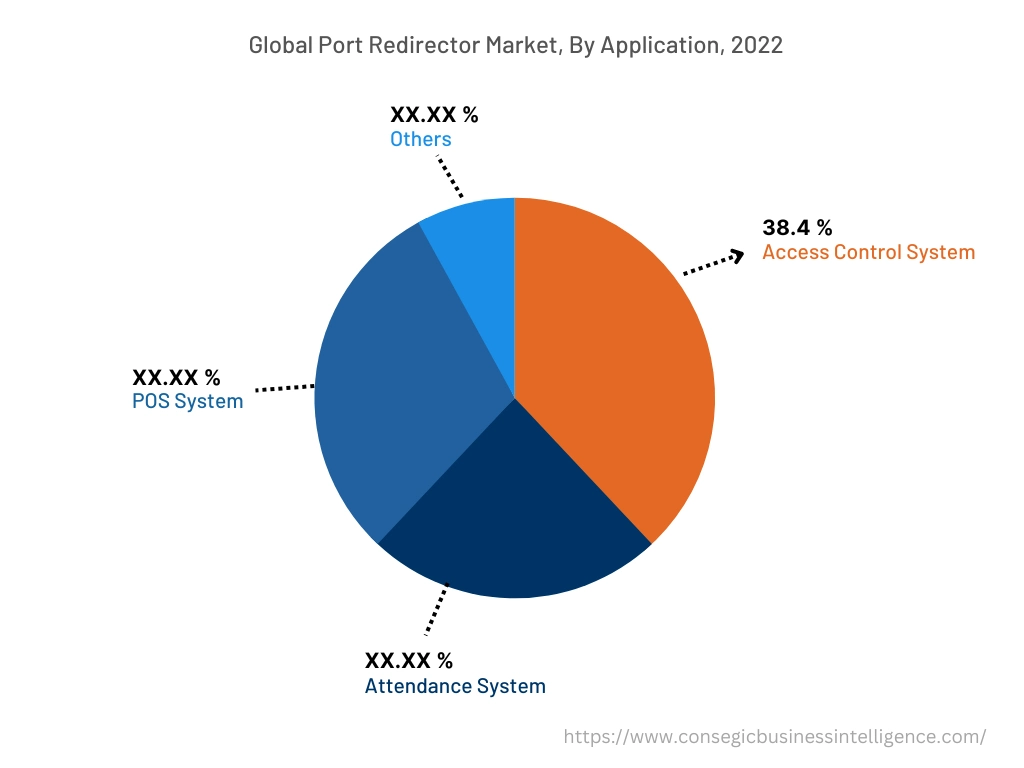
Based on the Region :
The regional segment includes North America, Europe, Asia Pacific, Middle East and Africa, and Latin America.
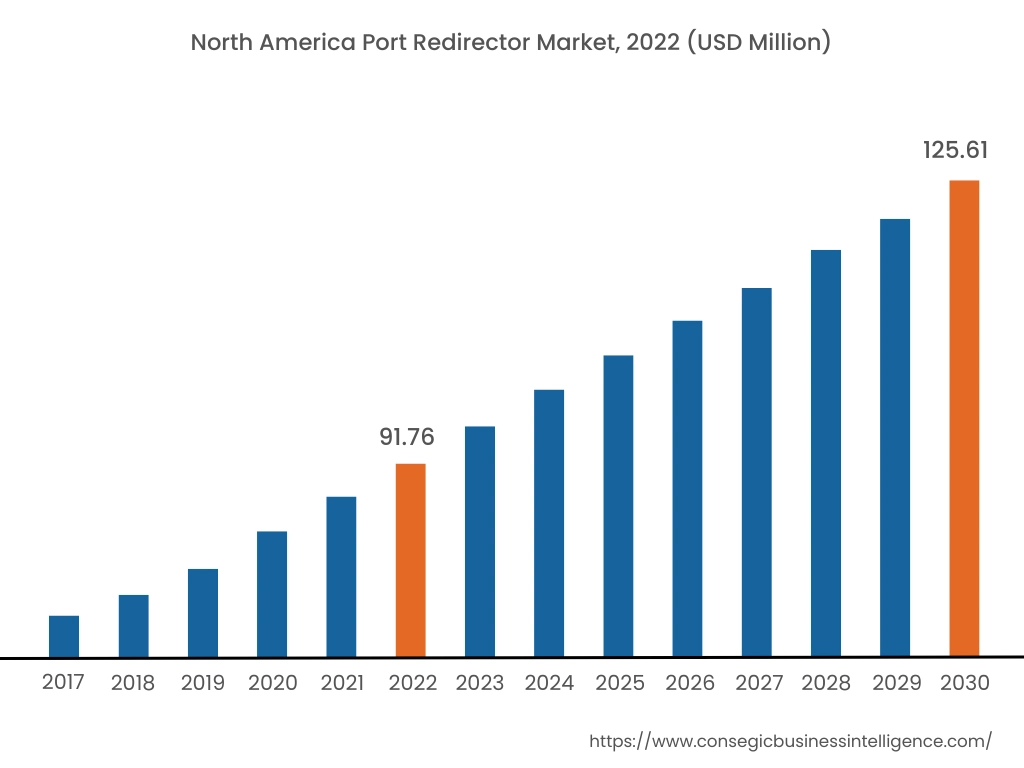
North America accounted for a revenue share of USD 91.76 million in 2022 and is expected to reach USD 125.61 million in 2030, registering a CAGR of 4.2% during the forecast period. Additionally, in the region, U.S. accounted for the largest revenue share of 60.40% in the year 2022. The high adoption of IT infrastructure across businesses including finance, healthcare, and telecommunications are driving the market growth. Businesses are increasingly focusing on network security and enhancing connectivity to ensure seamless operation of businesses. Moreover, the presence of a large number of data centers in North America is driving the growth of the port redirector market. For instance, according to CloudScene, in January 2022, the total number of data centers in United States was 2,701. Data centers deal with a large number of devices, applications, and servers that require port redirectors for efficient management of network traffic.
The Asia-Pacific region is anticipated to register fastest CAGR growth of 4.4% during the forecast period, 2023-30. The rising number of small and medium-sized enterprises in Asia-Pacific is propelling the growth of the port redirector market. Port redirectors are essential in facilitating communication and ensuring safety of the organizations, data, and systems. Moreover, the growing retail industry in the region is driving the demand for port redirectors for ensuring smooth transactional procedures. Port redirectors are deployed in POS systems for establishing communication between various devices such as POS software and barcode readers. Consequently, the rapid expansion of retail industry coupled with the increasing number of small and medium-sized enterprises is accelerating the growth of the regional market.
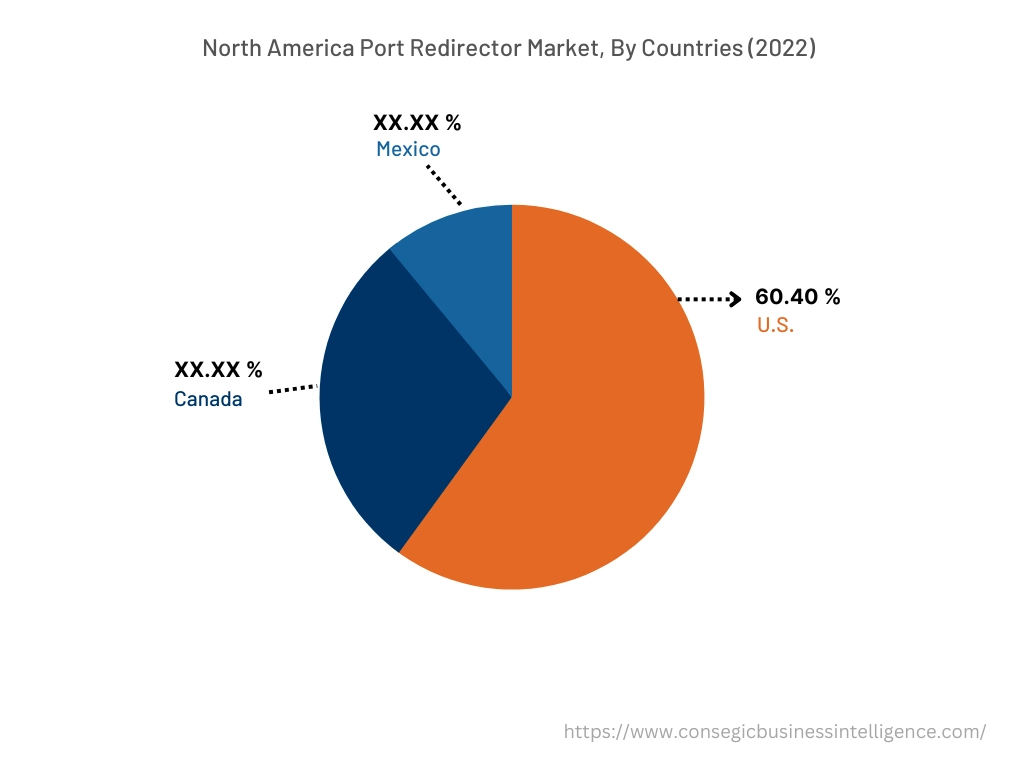
Top Key Players & Market Share Insights:
The port redirector market is highly competitive with major players providing port redirectors for ensuring safety of critical IT infrastructure. Key players are adopting several strategies in product innovation, research, and development (R&D), and various business strategies, and application launches have accelerated the growth of the port redirector market. Key players in the market include-
- Moxa Inc.
- Digi International
- Sena Technologies
- ORing Industrial Networking Corp.
- Advantech
- Siemens Industrial Communication
- OMEGA
- Korenix Technology
Recent Industry Developments :
- In February 2021, Lantronix, Inc. launched new EDS3000 family of serial-to-Ethernet device servers offering 8 to 16 ports for industrial and medical applications.
- In October 2022, Moxa Inc. launched industrial intrusion detection and prevention systems (IDS/IPS) for series secure routers called EDR-G9010 featuring threat detection capabilities to protect critical infrastructure from cybersecurity attacks.
Key Questions Answered in the Report
What is Port redirector? +
Port redirector is a component of networking that facilitates the redirection of incoming network traffic from one port to another. Port redirectors play a crucial role in ensuring safety and security of critical IT infrastructure.
What specific segmentation details are covered in the port redirector report, and how is the dominating segment impacting the market growth? +
By type has witnessed 1-port as the dominating segment in the year 2022, due to its ability to provide access control capabilities to enforce security policies in organizations.
What specific segmentation details are covered in the port redirector market report, and how is the fastest segment anticipated to impact the market growth? +
By application segment has witnessed POS systems as the fastest-growing segment during the forecast period due to the application of port redirectors in establishing communication between various devices of POS systems.
Which region/country is anticipated to witness the highest CAGR during the forecast period, 2023-2030? +
Asia-Pacific region is expected to register fastest CAGR growth during the forecast period due to the increasing number of small and medium-sized enterprises in the region.
